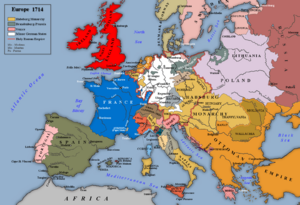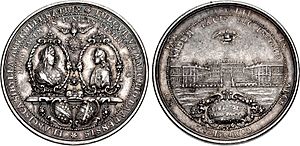Treaty of Rastatt facts for kids

|
|
| Context |
|
|---|---|
| Signed | 7 March 1714 |
| Location | Rastatt, Margraviate of Baden-Baden |
| Negotiators |
|
| Parties | |
| Language | French |
The Treaty of Rastatt was an important peace agreement. It was signed on March 7, 1714, in the city of Rastatt in Germany. This treaty ended the War of the Spanish Succession between France and Austria.
This treaty came after another important agreement, the Treaty of Utrecht, signed in 1713. That treaty had stopped the fighting between France, Spain, Great Britain, and the Dutch Republic. A third treaty, the Treaty of Baden, was needed to fully end the war between France and the Holy Roman Empire.
By 1713, everyone involved in the war was very tired. They had used up many resources and soldiers. It seemed unlikely that continuing the war would change anything. So, France and Austria began talking in November 1713. These talks led to the Treaty of Rastatt, which brought peace and added to the agreements made in Utrecht.
The main people who worked out the Treaty of Rastatt were Marshal of France, Claude Louis Hector de Villars for France, and Austria's Prince Eugene of Savoy. This treaty helped to create a new way of thinking about power in Europe, focusing on keeping a "balance of power" so no single country became too strong.
Contents
Why the Treaty Was Needed
Austria started talking about this treaty with France because its friends had left them. Great Britain, especially, had stopped supporting Austria during the talks for the Treaty of Utrecht.
Britain's Concerns About Power
Great Britain was worried. They feared that if Emperor Charles VI ruled both Austria and Spain, he would become too powerful. Charles VI had become the Holy Roman Emperor in 1711 and also wanted to be king of Spain. If he got both, it would make the House of Habsburg family too strong and upset the balance of power in Europe.
France's Military Actions
In June 1713, France started a military campaign along the Rhine River. They captured important places like Kaiserslautern, Landau, and Breisgau from the Holy Roman Empire. After these losses, Emperor Charles VI agreed to talk with Louis XIV of France again.
Changes in Land and Power

The Treaty of Rastatt changed who controlled certain lands.
New Lands for Austria
Under the treaty, Austria gained control of several Spanish lands in Italy. These included the Kingdom of Naples, the Duchy of Milan, and Sardinia. Austria also received the Southern Netherlands (which is now Belgium and Luxembourg). From France, Austria got Freiburg and some smaller areas near its eastern borders. However, France kept the city of Landau.
Austria's Growing Influence
Because of this treaty, the Habsburg Empire became very large. It was the biggest it had been since the lands of Charles V were divided in 1556. Austria became a powerful force in Western and Southern Europe, in addition to its strong position in Central Europe. The negotiations at Rastatt gave Austria more than what was first offered at Utrecht. Even so, Emperor Charles VI was upset about losing Spain. He felt the war's outcome was a big failure.
France's Gains and Limits
For France, the treaties of Utrecht and Rastatt confirmed that the House of Bourbon family would rule Spain. But France did not get the extra lands it had wanted. The treaties also made it clear that the thrones of France and Spain could never be joined under one ruler.
See also
 In Spanish: Tratado de Rastatt para niños
In Spanish: Tratado de Rastatt para niños
- List of treaties

